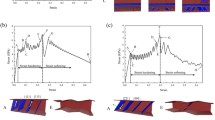Abstract
To determine whether plastic-hardening behavior occurs in metal nanowires, an atomistic simulation was performed to investigate the tension process in a bicrystal Cu nanowire. The results indicate that bicrystal Cu nanowires exhibit strain-hardening behavior, unlike their single-crystal counterparts. The strain-hardening behavior is related to the orientation of two crystal grains, and the number of atoms determines whether strain-hardening behavior occurs in the asymmetrically tilted bicrystal Cu nanowires. Strain hardening occurs in almost bicrystal Cu nanowires with different orientation angles. The initial yield stress is determined by the grain whose orientation angle is closer to 45° among the two crystal grains, resulting in a high value of the tilting tendency factor, and thus making it easier to generate slip.











Similar content being viewed by others
References
V.V. Bulatov, L.L. Hsiung, M. Tang, A. Arsenlis, M.C. Bartelt, W. Cai, J.N. Florando, M. Hiratani, M. Rhee, G. Hommes, T.G. Pierce, and T.D. de la Rubia: Dislocation multi-junctions and strain hardening. Nature 440, 1174–1178 (2006).
M.J. Buehler, A. Hartmaier, M.A. Duchaineau, F.R. Abraham, and H.J. Gao: The dynamical complexity of work-hardening: A large-scale molecular dynamics simulation. Acta Mech. Sin. 21, 103–111 (2005).
Y. Zhu, Q.Q. Qin, F. Xu, F.R. Fan, Y. Ding, T. Zhang, B.J. Wiley, and Z.L. Wang: Size effects on elasticity, yielding, and fracture of silver nanowires: In situ experiments. Phys. Rev. B 85, 45443 (2012).
C. Deng and F. Sansoz: Enabling ultrahigh plastic flow and work hardening in twinned gold nanowires. Nano Lett. 9, 1517–1522 (2009).
B. Wu, A. Heidelberg, and J.J. Boland: Mechanical properties of ultrahigh-strength gold nanowires. Nat. Mater. 4, 525–529 (2005).
R. Dou and B. Derby: The strength of gold nanowire forests. Scr. Mater. 59, 151–154 (2008).
L. Philippe, Z. Wang, I. Peyrot, A.W. Hassel, and J. Michler: Nanomechanics of rhenium wires: Elastic modulus, yield strength and strain hardening. Acta Mater. 57, 4032–4035 (2009).
D. Appell: Nanotechnology: Wired for success. Nature 419, 553–555 (2002).
Z. Wang, X. Zu, L. Yang, F. Gao, and W.J. Weber: Molecular dynamics simulation on the buckling behavior of GaN nanowires under uniaxial compression. Physica E 40, 561–566 (2008).
T. Zhu and H.J. Gao: Plastic deformation mechanism in nanotwinned metals: An insight from molecular dynamics and mechanistic modeling. Scr. Mater. 66, 843–848 (2012).
H.S. Park and J.A. Zimmerman: Stable nanobridge formation in <110> gold nanowires under tensile deformation. Scr. Mater. 54, 1127–1132 (2006).
Y.H. Wen, Y. Zhang, and Z.Z. Zhu: Size-dependent effects on equilibrium stress and strain in nickel nanowires. Phys. Rev. B 76, 125423 (2007).
C.R. Weinberger and W. Cai: Plasticity of metal nanowires. J. Mater. Chem. 22, 3277–3292 (2012).
C. Deng and F. Sansoz: Fundamental differences in the plasticity of periodically twinned nanowires in Au, Ag, Al, Cu, Pb and Ni. Acta Mater. 57, 6090–6101 (2009).
C. Deng and F. Sansoz: Effects of twin and surface facet on strain-rate sensitivity of gold nanowires at different temperatures. Phys. Rev. B 81, 155430 (2010).
A. Cao, Y.G. Wei, and E. Ma: Grain boundary effects on plastic deformation and fracture mechanisms in Cu nanowires: Molecular dynamics simulations. Phys. Rev. B 77, 195429 (2008).
D.E. Spearot, K.I. Jacob, and D.L. Mcdowell: Dislocation nucleation from bicrystal interfaces with dissociated structure. Int. J. Plast. 23, 143–160 (2007).
G.J. Tucker, J.A. Zimmerman, and D.L. Mcdowell: Shear deformation kinematics of bicrystalline grain boundaries in atomistic simulations. Modell. Simul. Mater. Sci. Eng. 18, 015002 (2010).
M.S. Daw and M.I. Baskes: Embedded-atom method: Derivation and application to impurities, surfaces, and other defects in metals. Phys. Rev. B 29, 6443–6453 (1984).
S.J. Plimpton: Fast parallel algorithms for short-range molecular dynamics. J. Comput. Phys. 117, 1–19 (1995).
C.L. Kelchner, S.J. Plimpton, and J.C. Hamilton: Dislocation nucleation and defect structure during surface indentation. Phys. Rev. B 58, 11085–11088 (1998).
Acknowledgments
This project is sponsored by the National Science Foundation of China (Grant No. 51175110) and the Fundamental Research Funds for the Central Universities (Grant No. HIT.KLOF.2010006).
Author information
Authors and Affiliations
Corresponding author
Rights and permissions
About this article
Cite this article
Yuan, L., Shan, D., Xu, Z. et al. Atomistic simulation of the strain-hardening behavior of bicrystal Cu nanowires. Journal of Materials Research 28, 3339–3346 (2013). https://doi.org/10.1557/jmr.2013.363
Received:
Accepted:
Published:
Issue Date:
DOI: https://doi.org/10.1557/jmr.2013.363




